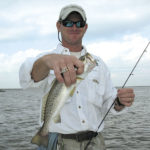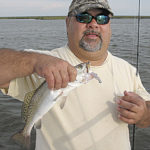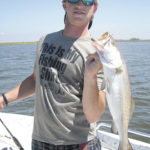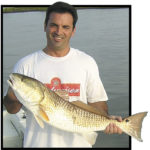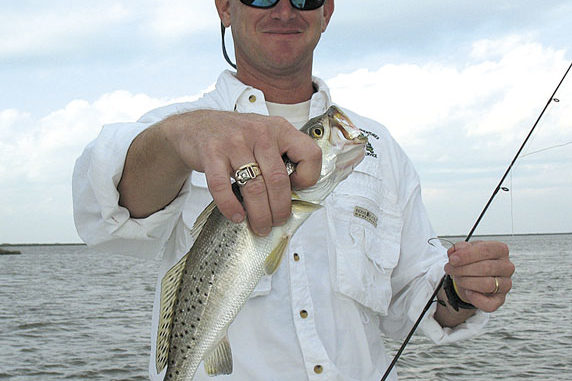
Follow this treasure map guide to plunder the plenty this underrated area has to offer.
The winds were already blowing steady out of the north when I arrived in the little St. Bernard community of Reggio. It’s a small hamlet on the side of Bayou Terre aux Boeufs on the way down to Delacroix Island.
There’s not much left to it anymore, and you’ll miss it completely if you blink your eyes. But the sleepy little community has a long and unique history, and one well worth exploring.
We were scheduled to fish with Capt. Darren Schaff (504-400-2466), co-owner of a camp in Reggio. He and his long-time fishing buddy, Emery Jee, were ready to go, and my sidekick, Sal Scurria, and I loaded our gear into Schaff’s 22-foot Shearwater bay boat and made our way down the Reggio Canal as daylight peeked over the horizon.
Most anglers zip right past Reggio, choosing to launch at the better-known Delacroix Island, which has a reputation for speckled trout and redfishing action that is hard to equal, and I might add, a reputation it richly deserves.
But don’t discount Reggio. It’s a gem that deserves some recognition, too.
From Reggio, it’s a short run down the Reggio Canal to a trinity of lakes that Schaff says will provide all the action an angler will need for fall fishing. And from there, it’s a hop, skip and jump to several other outstanding areas that will send you home with a good box of fish.
Schaff slowed the outboard to idle a long way from the first point he wanted to fish, and then killed it altogether to troll in more quietly. Fall fishing, while similar in many ways to summer and winter tactics, is different in that the fish are not deep yet like they will be in winter, and unlike summer action, they’re inside, along points and reefs and cuts, in shallow water.
Normally, I bring several rods rigged up different ways when summer fishing. I’ll have one rigged with a sliding sinker, another with a cork, another with a topwater bait and another with plastic for tightlining.
Schaff said I should come rigged for this fall trip with two rigs — a cork rig and a tightline rig. Topwater is still a good option under the right conditions, so if I needed it, I’d just tie one on my tightline rig.
“Usually, I’ll fish live shrimp at these points under a cork about 18 inches deep,” Schaff said as we crept almost to within casting distance of the shoreline.
The Power-Pole stuck in position, and we all started working our baits from there.
“This is really one of my favorite times of the year to fish, for several reasons,” Schaff said. “Think about it: The weather is so much more comfortable right now than that blistering summer heat and humidity. And the fish are in real close to the dock, so you don’t spend an hour running outside to find them.
“You save on fuel, you save on time, you save on bait because the further we get into fall, the less of a necessity live bait becomes. I use it right now whenever I anchor because it still outproduces plastics. But when drift fishing or trolling, I’m tossing plastics even now.”
We tossed our baits up close to the point where we anchored, and we tossed out away from the point as well to try to locate where the fish were hanging. We picked up a couple of keeper trout on the shrimp, and Jee caught a keeper drum on plastic.
From there, we moved on to another point to try again. That would be our procedure for the morning. Hit a spot, give it 10 or 15 minutes and fish it all around using several techniques — tightline, plastics and live shrimp under corks. If we hit a few, we stayed longer. If we drew a blank, we moved.
And steadily we added fish to the box.
“Let me tell you how productive this area is,” Schaff volunteered, gesturing toward the general area of Lake Amedee and Petain Lagoon. “I normally catch all my fish right in here, and rarely have to leave to look elsewhere. This area will hold fish even on windy days, and the water stays surprisingly clear under most conditions.”
He says the worst conditions are strong winds from the northwest that push the water out, and his favorite winds are light from the southeast.
The Reggio Trinity — Lake Amedee, Tanasia Lagoon and Petain Lagoon. According to Schaff, once you learn these areas, you’ll often fill your limits without having to look elsewhere.
• Lake Amedee.
“This is a pretty nice-sized lake, and there are several ways to fish it successfully,” Schaff said. “First I look for birds. You’ll often see a good flock of gulls diving over shrimp in Amedee, and it’s always worth a peek to see what’s under them.
“If you approach quietly and stay outside the school, you can peck away at it without spooking them.
“Next, you can fish points and cuts, and Amedee has plenty of them. Everybody has a favorite side, I personally prefer the east side.
“Anchor quietly, and toss live shrimp under a cork. If the fish are there, you’ll soon know it.
“Remember to give a spot a fair chance to settle down and produce after you anchor. If nothing’s happening after 10 or 15 minutes, move on. And once the winter chill begins, you can fish Amedee on the bottom at the mouth of Bayou Robin and Bayou Batola for specks.
“One of my favorite ways to fish Amedee is to drift it. You can drift either side or right down the middle, and catch fish either way. I like to stay about 100 yards off the shore when I drift, and I toss plastics under a popping cork, or I tightline plastic.”
His favorite colors are black/chartreuse, purple/white and, if he’s fishing under a popping cork, DOA shrimp in glow or Berkley Gulps.
Schaff says the water in Amedee usually stays clear, except under the worst wind conditions, and rising or falling tides are equally productive.
• Tanasia Lagoon.
“This is an easy one — fish the points,” Schaff said, for specks and reds.
Live shrimp under a cork is by far the best way to ensure success, he said.
“I don’t usually buy live minnows. I find that if they’ll hit minnows, they’ll hit plastics,” he said.
• Petain Lagoon.
“I fish Petain almost identical to the way I fish Amedee,” Schaff said. “Drift right down the middle, tossing plastics under a cork or tightlining, and keep off the bank by 100 yards or so.
“The south end of Petain is very shallow, so don’t venture back there except on high tides, or you can sit on points, cuts and coves and soak live shrimp about 12 to 18 inches under corks. The fish are already showing up in these areas so I expect a good fall fishing season.”
• Grand Lagoon.
Another of Schaff’s favorite fall spots, Grand Lagoon is a straight shot up the Twin Pipelines from the extreme northwest corner of Lake Amedee.
“Most of the Reggio marsh is very shallow,” he said, “great for duck hunters but unwise for anglers.
“But Grand Lagoon holds enough water to fish except on real low tides. It has 3 to 4 feet of water in the middle, and gets very shallow on the edges, so the key is to drift the middle, tossing plastics under popping corks.”
Schaff says the area really hits its prime this month, especially on a north or south wind.
“The middle holds trout, and the points and pockets hold reds,” he said.
• Bayou Batola.
“Bayou Batola is shallow in the wide stretch except in the middle, so drift it right down the center while tossing plastics under corks,” Schaff advised. “Gulps and DOAs are my favorites, or you can tightline plastics in purple/white or black/chartreuse. Usually by November, once the weather starts to chill, you can find trout in the sharp bends of Bayou Batola where the water is deep.”
• Lake Robin.
“I generally fish either the north side of Lake Robin at the cuts and points, or the west side,” Schaff said. “I anchor at the points where there is some good water flow, and cast live shrimp under a cork.
“Lake Robin produces reds and specks in the fall, and occasionally you’ll find fish under the birds, especially near the mouths of the bayous. The good thing about Lake Robin is that the water is almost always clear in it.”
Schaff never drift-fishes in Robin, but always anchors at points and cuts.
• Lake John.
Schaff really likes to fish Lake John, but only ventures onto the south side of Bayou Terre aux Boeufs on days when he’s having trouble finding fish.
“I can usually catch all we need in the areas around Amedee, but when I have one of those tough days finding fish, and they do come along, I’ll head over to Lake John or Four Horse,” he said. “Last year, Lake John was full of grass except for the middle, and it was perfect for drifting the middle and casting for reds and specks.
“We had some really good trips there, but like I said, that was last year. This year it didn’t grass up, so it remains to be seen how productive it’ll be. But I’ll fish it by drifting in the main lake tossing plastics, or anchoring at points and cuts, and the passes between Lake John and what they call Little Lake John.”
• Four Horse Lake.
“This is usually as far as I go in the fall,” Schaff said. “If I haven’t found the fish by this time, I’ll be about out of time, so Four Horse will be the last shot at success.
“Generally, I’ll drift the east bank, and if I get some action, I’ll stick the anchor and see if I can sit on it for awhile. Or I’ll anchor at cuts and points and the corners of the passes, and fish live shrimp. Both sides of the pass between Four Horse and Pato Cabello are good places to anchor, especially as we get to late October.”
The winds had increased to a steady 18 to 20 from the north, and since we already had a considerable amount of fish in the box, we decided to call it a day. It was nice not having to hunker down for the long haul back to the dock like we did in the summer because we were only 15 minutes from the dock when we wrapped it up.
Next time you plan a trip, put Reggio down as an excellent option.
Capt. Darren Schaff can be reached at (504) 400-2466.
